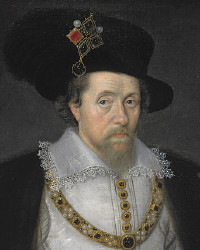Sancy (diamond)
The " Sancy diamond " (not to be confused with the Beau Sancy , also called "little Sancy", with 34.98 carats) is a 55.23 carat (11.046 g) diamond. The stone is one of the most famous diamonds in the world, together with the Orlow of Tsarina Catherine II , the Florentine of the Medici , the Blue Hope Diamond , the Blue Wittelsbacher and the Green Dresdener . It was the main stone of the royal crown of Louis XV. of France .
history
Its first known owner was the Duke of Burgundy, Charles the Bold , who is said to have carried it with him as a talisman in the Battle of Nancy (1477). The duke fell; a soldier is said to have found the diamond on the dead man and then sold it to Portugal .

In 1570 Nicholas Harlay de Sancy, from a Huguenot family and ambassador to the court of Sultan Selim II in Constantinople , acquired a slightly greenish-yellowish diamond and gave it its later name. At the time, Seigneur de Sancy was a prominent figure at the court of King Henry III. Under his successor, King Henry IV , Seigneur de Sancy was appointed Minister of Finance. He gave the diamond as security for a loan to recruit soldiers. A messenger was sent to Solothurn with the diamond , but did not reach its destination. Seigneur de Sancy was certain that the messenger was loyal and let him be found. The dead messenger was found, apparently ambushed by thieves who had followed him. Sancy had the body opened and the diamond removed from the stomach. In 1596 Nicholas Harlay de Sancy was in dire straits and sold the diamond to Queen Elizabeth I of England - from then on the diamond was one of the crown jewels of the English Kingdom.
After the outbreak of the English Civil War (1642) and with the execution of King Charles I (1649), which ended with the interruption of the monarchy, his widow Henrietta Maria de Bourbon gave the diamond to Edward Sommerset, 2nd Marquess of Worcester, through which the stone went back to the English crown. After his defeat in the Battle of the Boyne , King James II fled to France . For want of money, he sold the gemstone to King Louis XIV , who was known for his love for diamonds.
In 1792, at the beginning of the French Revolution , the French crown jewels, including the Sancy diamond , were stolen from the royal treasury in Paris . The stone did not reappear until 1828 at a Parisian diamond dealer, who sold it to the Russian industrialist Anatole Demidoff, Prince di San Donato . Since he had a love affair with a noble lady, his wife Princess Mathilde Lætitia , a cousin of Emperor Napoléon III , left him in 1845 . , together with her lover and the Turin jewelry collection . After her death (1904) the Sancy diamond was exhibited by the jeweler Monsieur Gérard Bapst in Paris. There it was offered for a million francs.
In 1906 the Sancy was acquired by William Waldorf Astor as a wedding present for the marriage of his son Waldorf Astor (1879-1952) to Nancy Langhorne . In 1962, the Sancy diamond was a highlight at the Louvre jewelery exhibition . After Lady Astor's death in 1964, the famous diamond was bequeathed to her son. The Sancy is now in the Apollo Gallery in the Louvre.
See also
literature
- Victoria Finlay: Jewels: A Secret History . Random House Trade Paperbacks, 2007, ISBN 0-3454-6695-0
- Richard W. Wise: Secrets of the Gem Trade: The Connoisseur's Guide to Precious Gemstones . Brunswick House Press, 2006, ISBN 0-9728-2238-0
- Stefano Papi and Alexandra Rhodes: Famous Jewelry Collectors . Thames & Hudson, 2004, ISBN 0-5002-8512-8
- Susan Ronald: The Sancy Blood Diamond: Power, Greed, and the Cursed History of One of the World's Most Coveted Gems . Wiley, 2004, ISBN 0-4714-3651-8
- Vincent Meylan: Queens' Jewels . Assouline, 2002, ISBN 2-8432-3364-X
- Geoffrey C. Munn: Tiaras - A History of Splendor . Antique Collectors Club, 2001, ISBN 1-8514-9375-1
Web links
- The Sancy Diamond (English)
- The Sancy Diamond (English)
- Diamond Lore - Sancy (English)
Remarks
- ↑ Ronne Peltsman and Neil Grant: Diamonds - Myth, Magic, and Reality
- ^ Ian Balfour : Sources: Famous Diamonds
- ^ Susan Ronald: The Sancy Blood Diamond: Power, Greed, and the Cursed History of One of the World's Most Coveted Gems , Wiley (2004) ISBN 0-4714-3651-8
